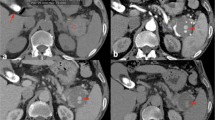Abstract
Conservative therapy for splenic injuries is widely advocated. The advantages of conservative therapy for splenic injuries include the preservation of splenic immune function, prevention of overwhelming post-splenectomy sepsis, and avoidance of laparotomy and its associated early and late complications. Pseudoaneurysms of the splenic artery branch are encountered because of the prevalence of conservative management and widespread use of imaging techniques in the follow-up of these cases. We report two cases of post-traumatic splenic pseudoaneurysm in children which thrombosed spontaneously, one during the diagnostic angiogram examination and another on follow-up studies.


Similar content being viewed by others
References
Hiraide A, Yamamoto H, Yahata K, et al (1994) Delayed rupture of the spleen caused by an intrasplenic pseudoaneurysm following blunt trauma; case report. J Trauma 36:743
Davis KA, Fabian TC, Croce MA, et al (1998) Improved success in nonoperative management of blunt splenic injuries: embolization of splenic artery pseudoaneurysm. J Trauma 44:1008–1013
Orlando G, Gianluca G, Piero V, et al (1996) Intrasplenic posttraumatic pseudoaneurysm: echo color Doppler diagnosis. J Trauma 41:542–545
Kathirkarnathan S, Stuart EM, Robin BK, et al (2000) Nonsurgical management of blunt splenic injury: use of CT criteria to select patients for splenic arteriography and potential endovascular therapy. Radiology 217:75–82
Hagiwara A, Yukioka T, Ohta S, et al (1996) Non surgical management of patients with blunt splenic injury: efficacy of transcatheter arterial embolization. AJR Am J Roentgenol 167:159–166
Soffer D, Bar ZD, Metser U, et al (2002) Spontaneous thrombosis of a splenic pseudoaneurysm after blunt abdominal trauma. J Trauma 53:383–385
Author information
Authors and Affiliations
Corresponding author
Rights and permissions
About this article
Cite this article
Raghavan, A., Wong, C.K.F., Lam, A. et al. Spontaneous occlusion of post-traumatic splenic pseudoaneurysm: report of two cases in children. Pediatr Radiol 34, 355–357 (2004). https://doi.org/10.1007/s00247-003-1101-8
Received:
Revised:
Accepted:
Published:
Issue Date:
DOI: https://doi.org/10.1007/s00247-003-1101-8




